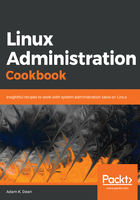
firewall-cmd
Firewalld (the daemon controlled by firewall-cmd) introduces the concept of zones to the Linux firewall.
Zones are assigned to specific interfaces, with specific rules configured per zone.
You can list the currently configured zones using firewall-cmd, too:
$ sudo firewall-cmd --get-zones
block dmz drop external home internal public trusted work
To check which zone we're actively using, and on which interface, we use --get-active-zones.
In the following code, we can see that eth0 and eth1 are using the public zone:
$ firewall-cmd --get-active-zones
public
interfaces: eth0 eth1
Because eth0 is active under public, let's list the details of the public zone:
$ sudo firewall-cmd --list-all --zone public
public (active)
target: default
icmp-block-inversion: no
interfaces: eth0 eth1 eth2
sources:
services: ssh dhcpv6-client
ports:
protocols:
masquerade: no
forward-ports:
source-ports:
icmp-blocks:
rich rules:
Here, we can see that the services this zone is aware of are ssh and dhcpv6-client.
We can specifically list the services of a zone using --list-services:
$ sudo firewall-cmd --zone public --list-services
ssh dhcpv6-client
If we want information about exactly what that service allows, we can use --info-service.
In the following code, we're looking at ssh, discovering that it allows port 22/tcp through:
$ sudo firewall-cmd --info-service ssh
ssh
ports: 22/tcp
protocols:
source-ports:
modules:
destination: